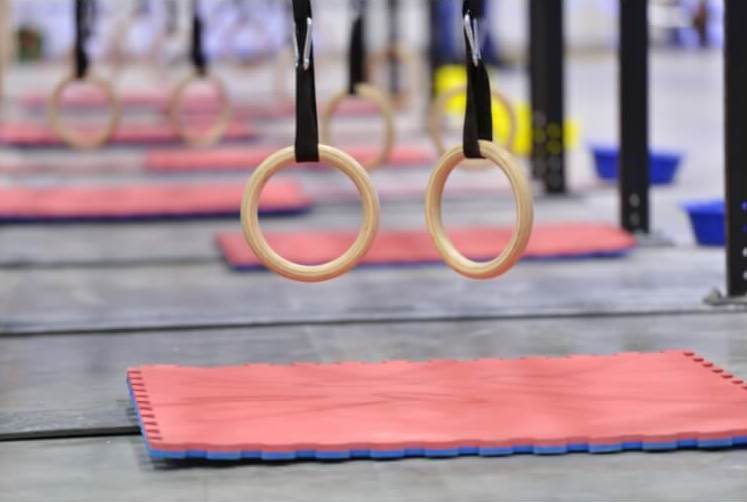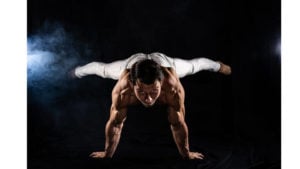Gymnastics rings are the ultimate and most important piece of calisthenics equipment for every athlete interested in bodyweight fitness. If there was only one fitness instrument we could take with us to a deserted island it would be a set of rings - you got to have your priorities straight.
SPECIAL DEAL: Die Ringe app (check the full review here) is offering a free set of gymnastics rings with every annual subscription. You can get 10% off with the 👉 Calisthenics Special offer.
What are the benefits of gymnastics rings?
Gymnastics rings are easily one of the most versatile pieces of equipment in calisthenics. Whether you’re a beginner just getting started with bodyweight rows or an advanced athlete training for front levers and strict muscle-ups, rings adapt to your level and goals.
What makes them so unique is their instability—they force your body to engage more muscles to maintain control and alignment. That means even simple exercises like push-ups or dips become far more challenging and effective when performed on rings. You’re not just working the prime movers; you’re building serious joint stability, grip strength, and coordination all at once.
Personally, I love how portable they are too. I can hang them from a tree, a pull-up bar, or even a sturdy door frame and get a complete upper body and core workout wherever I go. I often recommend them to anyone training at home or traveling, because they offer so many options in such a compact package.
If you’re curious about what kinds of exercises you can do with rings, check out the exercise library on Calisthenics.com—you’ll find everything from beginner-friendly movements to advanced skills that’ll keep you progressing for years.
Gymnastics rings are light and fit easily in any backpack so they are ideal for a traveling athlete. Finding a place to hang them from can be challenging though but not a big problem. Just find a stable enough horizontal tree branch in a nearby park and you are good to go.
The best part about gymnastics rings is how cheap and simple they are. They cost around $50 and they can serve you a lifetime. There is no technology, and there is no need to update it every year. There are no pivot points, nothing to break on them.
Since it's one-size-fits-all, you can always lend one to your friends for their next trip.
In summary, the main benefits of gymnastics rings are that they are:
- Light - easy to travel with
- Packable - fits in a backpack
- Easy setup - only needs a stable horizontal surface
- Universal - one size fits all
- Versatile - whole upper body workout
- Cheap - around $50
- Simple - will not break easily
- Any fitness level - great for beginner to advanced
Where to buy gymnastics rings?
Premium Wooden Gymnastics Rings
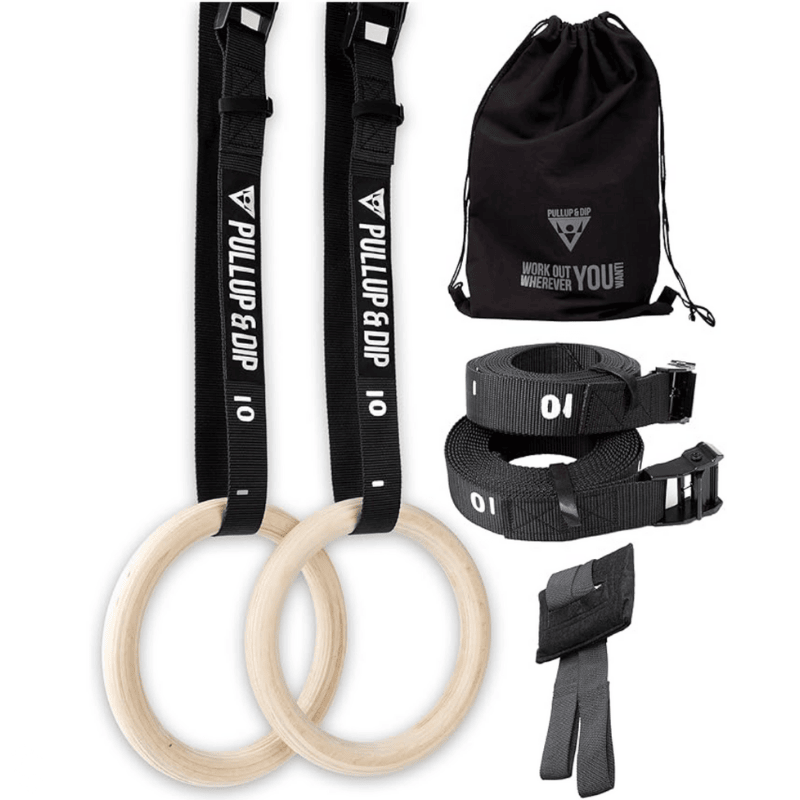
*not from the US? Check on:
- PULLUP&DIP (DE) use code CALIS10 for 10% off
- GORNATION (UK&EU) use code CS10 for 10% off
- Made of high quality birch wood
- Olympic standard sizing
- Extra wide straps with numbered length markings for easy adjustment
- Quick release buckles for increased safety
Wooden Gymnastics Rings
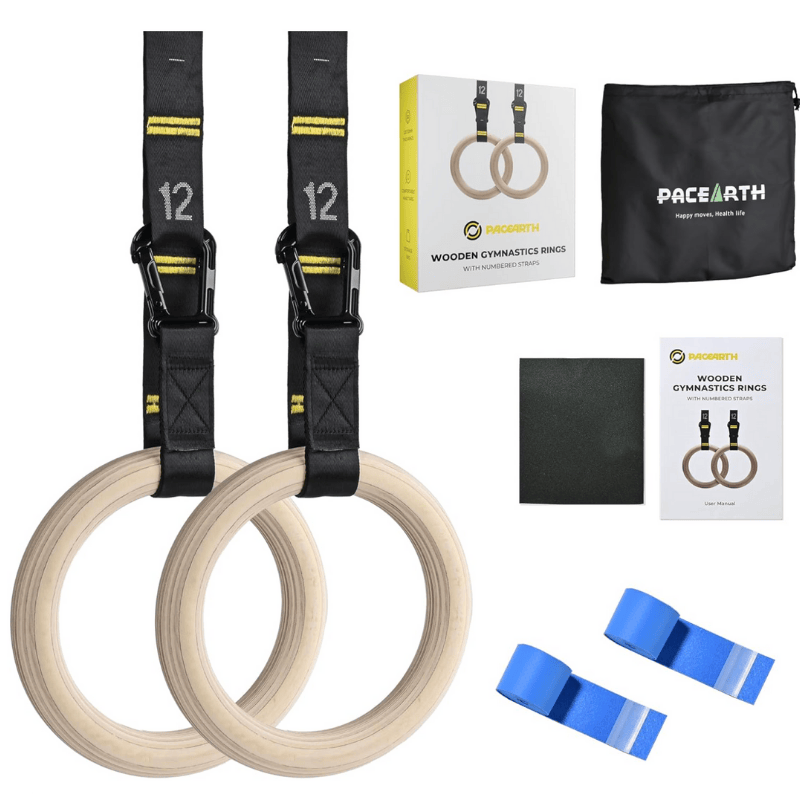
- Made of wood for comfortable grip
- Multiple sizing options
- Extra wide straps with numbered length markings
- Carabiner closure for simple setup
What is the best material for gymnastics rings?
In general, the materials used to make gymnastics rings can vary between
- wood
- plastic
- metal (steel or aluminum)
From my own experience training with all kinds of rings—plastic, metal, and wood—nothing compares to the feel of wooden rings, especially those made from birch. The grip is just on another level. Birch absorbs chalk and a bit of moisture from your hands in a way that gives you a dry, secure hold without tearing up your skin. I’ve noticed this makes a huge difference during longer workouts or high-skill moves like muscle-ups and front levers. With plastic rings, I always felt a slight slip, and metal ones just felt cold and unforgiving. Birch, on the other hand, feels warm, natural, and grippy right from the start.
What I also love about birch is how strong and lightweight it is. It has a smooth, consistent finish that’s comfortable for high-rep workouts but still holds up to heavy static holds and dynamic training. I’ve been using the same birch rings for years now, indoors and out, and they’ve never warped, splintered, or let me down. They just feel solid and reliable—something you don’t fully appreciate until you’re hanging upside down mid-set and need to trust your gear completely. For me, birch wood rings are hands-down the best investment I’ve made in my calisthenics setup.
Metal rings
Typically rings in public calisthenics parks are made of steel or aluminum as they are the most resistant to wear and the weather. Unfortunately, they are very heavy and rough so working out on them takes some getting used to.
Plastic rings
Plastic gymnastics rings are usually the lowest quality and they are the cheapest to manufacture. The benefit of these rings is that they are the lightest and most resistant to water. Even though they are completely functional we would not recommend them if you can afford the wooden version.
Wooden rings
The best gymnastics rings are made of birch wood where the surface of the rings is untreated and sanded down to provide a natural feel and optimal grip. This is also the material that has been used in competitive gymnastics for decades. Some of the more premium gymnastics rings are made of more exclusive materials such as walnut or maple wood. These are usually significantly more expensive and the benefits tend to be purely aesthetic if any.
What is the best thickness for gymnastics rings?
While the inner diameter of gymnastics rings tends to be uniform at 7.1” (18cm) the thickness varies between the two standard sizes:
- Standard: 1.25″ or 32 mm
- FIG: 1.1” or 28 mm
The FIG version is the official size used in gymnastics competitions. To ensure optimal grip for gymnasts who wear a thick layer of padding on their hands it has to be thinner. Since most of us train with bare hands, the best thickness for gymnastics rings for most athletes is 1.25” (32mm). Of course, for athletes with smaller hands, it is perfectly fine to choose the FIG version - whatever feels better.
Setting up the gymnastics rings
How to hang gymnastics rings at home?
Gymnastics rings are the perfect equipment for a home gym because they are easy to install and take up very little space. All you need is a place to hang the straps from. For a minimalist solution, we recommend using a ceiling hook set to hang the straps from. The mounting points should be about 19.7 inches (50cm) from each other. Once set, the ring straps can be detached after every use so they won’t be in the way.
The gymnastics rings can also be set up for any pull or push movement. The good thing about them is that they are easily height adjustable. By adjusting the height of the rings and the position of your feet you can modify the difficulty of exercises and the muscle groups engaged. By putting your feet on a box or chair the difficulty can be further modified.
The gymnastics rings at the Olympics are hanging from a height of 18.8 feet (5.75m) and the rings are 8.2 feet (2.5m) above ground. For home use, these dimensions are not too practical as few of us have such high ceilings.
In order to be able to perform the exercises it is important that the gymnastics rings are set up correctly. For example, to perform a front lever, we have to pay attention to the distance between our head and the wall, when in the fully extended horizontal position.
For example: I am 6.2’ or 188cm tall. If I wanted to do a full muscle up, I would need a ceiling height of 11.1 feet (340 cm). The rings would have to be 7.5 feet (230 cm) from the ground for me to be able to fully extend my legs in a dead hang position and after completing the muscle-up I’d need a further 43 inches (110cm) - the top of the dip - to not hit my head into the ceiling. I could of course modify the muscle up and start from an L-hang position, this way a standard ceiling height would also suffice.
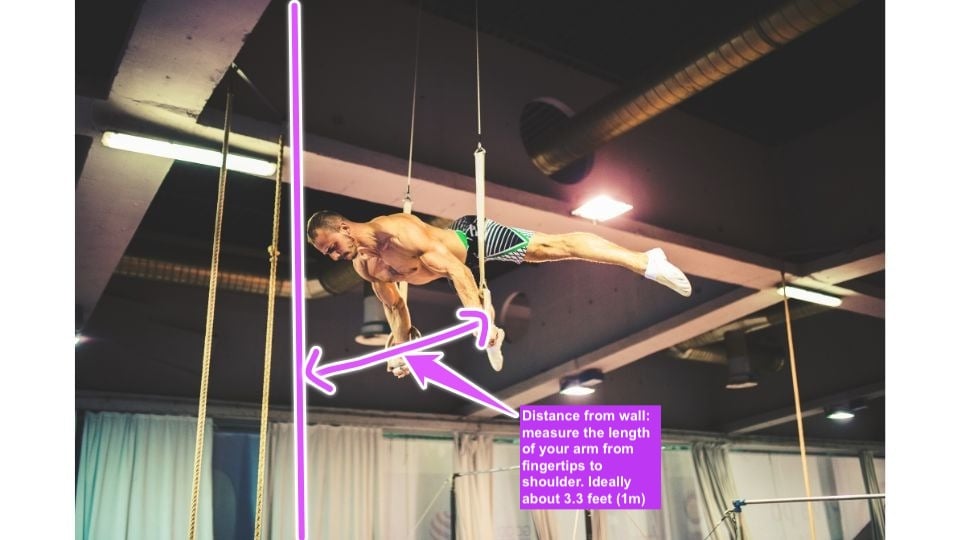
For a planche, front lever, or back lever position we also need to measure the minimum distance from the wall. You can easily determine the ideal position for your gymnastics rings by measuring your body in the following way:
- Distance from the ceiling (measure from knuckles to top of your head). For me it’s about 43” or 110 cm.
- Distance from the wall (measure the length of your arm. From fingertips to shoulder). For me it’s 31.5” or 80 cm. To be safe I'd recommend 3.3 feet or 1m.
- Distance from the floor - for muscle up (Body height + distance between elbow and fingertips). For me it’s 7.55 feet or 230 cm.
- Distance from the floor - for a dip (measure from chest to bottom of your feet). For me it’s 55” or 140 cm.
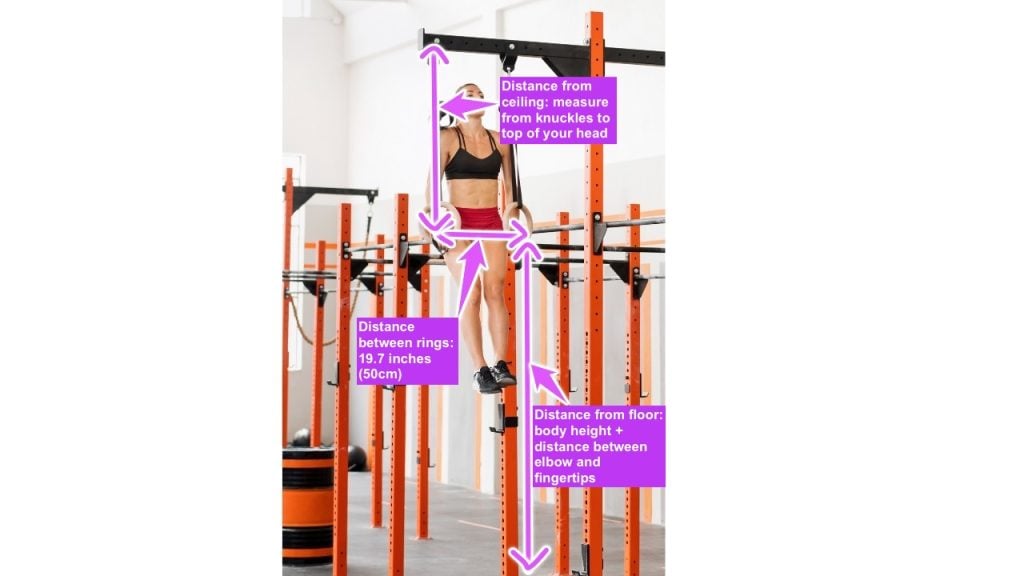
How far apart gymnastics rings should be?
The best way to hang gymnastics rings is on a high enough pull-up bar (or tree branch) because this way the straps can be adjusted easily as needed.
Another way to install gymnastics rings is to drill two attachment points into the ceiling. This solution is more permanent so it’s important to get the width right the first time.
We recommend installing the gymnastics rings slightly wider than shoulder-width apart so supporting yourself in the top of the dip position feels natural - with arms extended and held close to the body. The official FIG (International Gymnastics Federation) specification says that the rings should be 50cm or 19.7 inches apart from each other.
Bottom line
To summarize, gymnastics rings belong to everyone's home gym who is serious about working out at home. They are versatile enough to help you train almost any upper body exercise and some leg workouts too. Their practicality lies in their size and portability.
If the budget is tight just pick up these cheap set of rings from Amazon (affiliate link). They are good value for money and come with a carabiner buckle, which makes the setup even simpler.
Good luck with your training!

